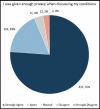Patient perception regarding privacy and confidentiality: A study from the emergency department of a tertiary care hospital in Karachi, Pakistan
- PMID: 35310808
- PMCID: PMC8899898
- DOI: 10.12669/pjms.38.ICON-2022.5785
Patient perception regarding privacy and confidentiality: A study from the emergency department of a tertiary care hospital in Karachi, Pakistan
Abstract
Background and objective: Maintaining privacy and ensuring confidentiality with patients is paramount to developing an effective patient-provider relationship. This is often challenging in over-crowded Emergency Departments (EDs). This survey was designed to explore patients' perceptions on maintenance of privacy and confidentiality and their subsequent interactions with providers in a busy tertiary care hospital in Karachi.
Methods: Trained nursing staff conducted structured interviews with 571 patients who presented to The Indus Hospital (TIH) ED from January to December 2020. All patients were 14 years of age or older, could speak and understand Urdu, and provide informed consent. Patients were asked about their perceptions of privacy and confidentiality in the ED and whether this affected their interactions with providers.
Results: Respondents were primarily men (64%) under the age of 45 (62%) presenting for the first time (49%). The majority of patients felt that privacy and confidentiality were maintained, however 10% of patients reported that they had rejected examination due to privacy concerns and 15% of patients reported that they had changed or omitted information provided to a provider due to confidentiality concerns. There was correlation between privacy and confidentiality concerns and patient-provider interactions (p<0.0001).
Conclusions: Despite the often over-crowded and busy environment of the ED, patients generally felt that privacy and confidentiality were maintained. Given the correlation between perception and behavior and the importance of an effective patient-provider relationship, particularly in the acute setting when morbidity and mortality is high, initiatives that focus on maintaining privacy and confidentiality should be pursued.
Keywords: Confidentiality; Emergency Department; Patient perception; Patient-provider interactions; Privacy; Survey.
Copyright: © Pakistan Journal of Medical Sciences.
Conflict of interest statement
Conflicts of Interest: None.
Figures




References
-
- Gostin LO, Levit LA, Nass SJ. Beyond the HIPAA privacy rule:Enhancing privacy, improving health through research. National Acad Sci. 2009:NBK9578. doi:10.17226/12458. - PubMed
-
- Siegler M. Confidentiality in medicine—a decrepit concept. Mass Medical Soc. 1982;307:1518–1521. doi:10.1056/NEJM198212093072411. - PubMed
-
- Gordon J, Sheppard LA, Anaf S. The patient experience in the emergency department:A systematic synthesis of qualitative research. Int Emerg Nurs. 2010;18(2):80–88. doi:10.1016/j.ienj.2009.05.004. - PubMed
-
- Asplin BR, Magid DJ, Rhodes KV, Solberg LI, Lurie N, Camargo CA., Jr A conceptual model of emergency department crowding. Ann Emerg Med. 2003;42(2):173–180. doi:10.1067/mem.2003.302. - PubMed
-
- Bartlett S, Fatovich DM. Emergency department patient preferences for waiting for a bed. Emerg Med Australas. 2009;21(1):25–30. doi:10.1111/j.1742-6723.2008.01147.x. - PubMed
LinkOut - more resources
Full Text Sources
